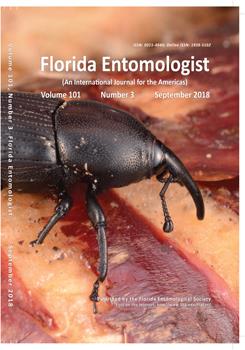We report the natural occurrence of M. rileyi in larval A. gemmatalis and T. ni in soybean producing regions of Altamira, Tamaulipas, and Pánuco, Veracruz, Mexico, during Aug through Dec 2017. A total of 380 M. rileyi-infected A. gemmatalis larvae were collected from Altamira and Pánuco. In each municipality, only 1 larval T. ni was found infected with the fungus. In Oct, the greatest number of A. gemmatalis larvae infected by M. rileyi was recorded from both municipalities.
In Mexico, Anticarsia gemmatalis Hübner (Lepidoptera: Erebidae) and Trichoplusia ni Hübner (Lepidoptera: Noctuidae) feed on soybean crops (Ávila et al. 2006), but A. gemmatalis is considered the principal pest because of the damage it causes (Gamundi et al. 2010). In several parts of the world, both defoliating insects are affected by Metarhizium rileyi (Farl.) Kepler, S. A. Rehner & Humber (Hypocreales: Clavicipitaceae) (Palma & Del Valle 2015). This fungus is pathogenic and virulent to 30 species of Lepidoptera (Iqtiat et al. 2009). In this study, we report the natural occurrence of M. rileyi in the larvae of A. gemmatalis and T. ni in the states of Tamaulipas and Veracruz, Mexico.
From Aug to Dec 2017, A. gemmatalis and T. ni larvae were collected from soybean crops in the municipalities of Altamira, Tamaulipas (22.573211°N, 98.178025°W), and Pánuco, Veracruz (21.974477°N, 98.441155°W). Larvae were collected using a simple random sampling design where they were collected manually at each sampling point. Samples were transported to the biological control laboratory of “Las Huastecas” Experimental Field of the National Institute of Forestry, Agriculture, and Livestock Research (INIFAP) in Villa Cuauhtémoc, Tamaulipas, Mexico. In the laboratory, larvae were incubated at 25 ± 2 °C for 15 d. At the end of this period, fungus present in the larvae was used to inoculate dextrose and potato agar medium, then incubated at 25 ± 2 °C until sporulation. A total of 371 A. gemmatalis larvae were collected from Altamira, Tamaulipas, and 9 from Pánuco, Veracruz; all were infected by M. rileyi (Fig. 1A). In each municipality, only 1 collected larva of T. ni was infected with the fungus (Fig. 1B). Metarhizium rileyi was identified using the taxonomic keys of Samson (1981) as shown in Figures 1C and D.
It has been reported that M. rileyi causes mortality in larval A. gemmatalis, T. ni, Helicoverpa armigera Hübner, H. punctigera Wallengren, Spodoptera litura Fab., and S. frugiperda Smith & Abbot (Lepidoptera: Noctuidae) in Australia, China, India, Thailand, Cuba, Palestine, Brazil, Argentina, and the United States, respectively (Glare 1987; Tang & Hou 1998; Vimala Devi et al. 2003 ; Srisukchayakul et al. 2005; Céspedes et al. 2008; Iqtiat et al. 2009; Bortolotto et al. 2015; Duarte da Costa et al. 2015; Namasivayam & Bharani 2015; Palma & del Valle 2015).
In Mexico, the fungus has been reported in larval S. frugiperda, Spodoptera exigua Hübner, Helicoverpa zea Boddie, and Heliothis virescens Fab. (Lepidoptera: Noctuidae) (Vega-Aquino et al. 2010), as well as A. gemmatalis in soybean crops from Tamaulipas (Ávila et al. 2006). For the first time, we report the natural occurrence of M. rileyi in the larvae of A. gemmatalis and T. ni collected from the soybean producing areas of Pánuco, Veracruz, as well as T. ni from Altamira, Tamaulipas. In both municipalities, the greatest number of larvae infected by the fungus was recorded in Oct 2017.
Fig. 1.
Larvae of (A) Anticarsia gemmatalis and (B) Trichoplusia ni infected by Metarhizium rileyi, collected from soybean plants in the states of Tamaulipas and Veracruz, Mexico; (C) Conidiophores of M. rileyi at 100× magnification and dyed with cotton blue; (D) Spores of M. rileyi at 100× magnification and dyed with cotton blue.






